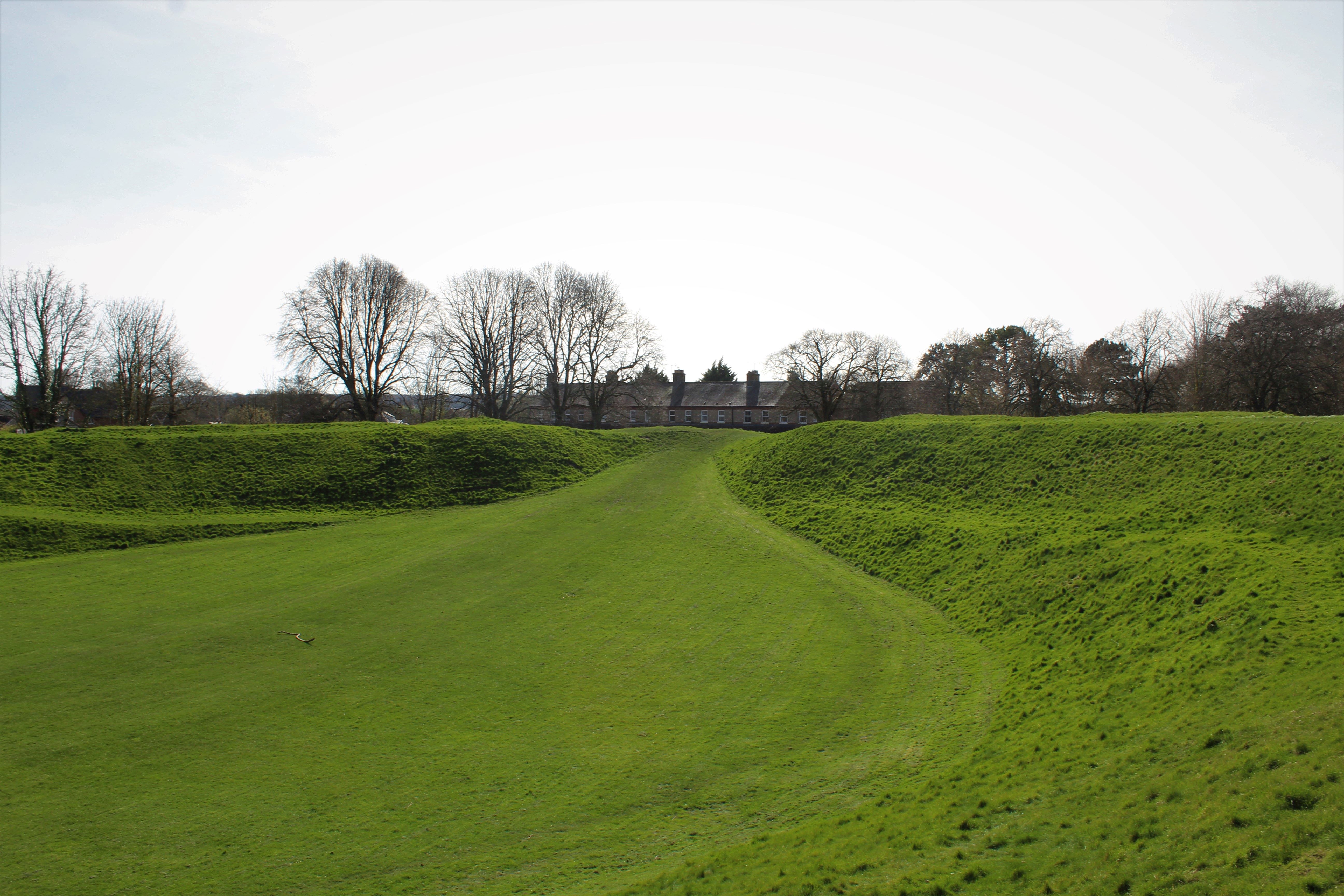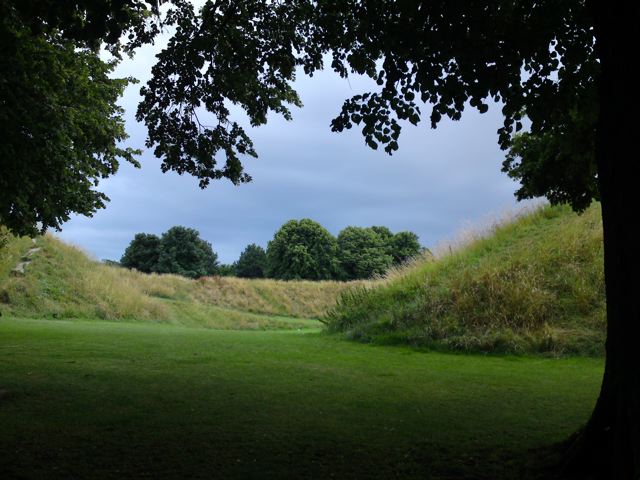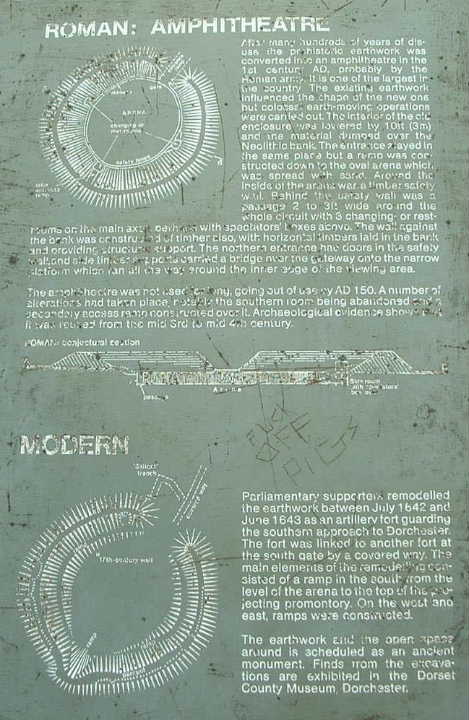







From one of the information boards

Open Source Environment agency LIDAR

Almost 180º panorama from the North East. Amazing that something as big as this can be squirrelled away in a town centre.


Looking down across the wider entrance to the North.



15/1/11

15/1/11

Trees in winter.

Henge interior, New Year’s Eve.

Looking down on the entrance from the northeastern quadrant of the bank.

The entrance.

The henge from the northwest.

This 1755 picture of the rings appears in Francis Grose’s 1777 ‘Supplement to the Antiquities of England and Wales’. I feel a bit irked that I overlooked this place when I visited Maiden Castle last year. I blame it on the totally roman-centric brown ‘amphitheatre’ signs everywhere. (plus no research on my part).
That’s a gallows on the horizon which is a bit ghastly. Grose says that the bank is “somewhat injured on the side next the gallows, by the trampling of men and horses at executions... At Mrs Channing’s execution (A D 1705) there were supposed to be 10,000 spectators present, who filled the sides, top, and area of this work...” Very unpleasant.

July 2009

July 2009



Mmmm cock. This is a chalk phallus found at the bottom of one of the mighty shafts at the rings. It’s currently in Dorset County Museum.

Good Friday 06

the path leading up onto maumbury ring at the entrance

looking back at the entrance to maumbury ring

sign at Maumbury (right part)

sign at Maumbury (left part)

Maumbury Ring 2 – 4.9.2002
Jo remembered having lunch here on a school trip many years ago!

Maumbury Ring 1 – 4.9.2002
Jo remembered having lunch here on a school trip many years ago!

Taken 4.9.2002. Not sure what that is obscuring lens.....

Taken 4.9.2002

Maumbury Rings has roads on two sides of it & houses / industry on the other two sides. Which is nice.

From the Car Park across the road

Maumbury rings: Looking North from the South Bank

To find that this still exists right in the middle of town is pretty remarkable. Me and Mick spent a sunny September hour in the late afternoon, watching the locals go by.
Great Open air vanue :-)
We visited the site and found it to be well preserved despite local children using it for a huge BMX ramp/racing circuit. There was loads of spaces to park the car on the roadside, and free too. We found it to be a really impressive place to visit due to the size of the ring and that once we stood in the middle all the surrounding roads and traffic lights are completely out of view making it easier to imagine how it might have been before the surrounding area became so built up.
Flying visit to this for the umpteenth time it seems, though the first in many years, this time to take a few alternate photos for TMA.
Its bigger than I remember and slightly more intimidating as well. I could picture the baying hordes sat on the banks in Roman times urging the gladiators on; the enlargements they made to the bank seemed to be to the fore in my mind.
Its a shame (as ever) that the standing stone from the entrance was removed as I feel that would help to make the site more respected. Currently its mostly used as a hangout for local kids...
MAUMBURY RING & MOUNT PLEASANT – Visited 17/4/00
Oh...that will be it we said, as a great green mound appeared in the streets of Dorchester. Has anyone else noticed that the Cope’s picture has been printed back to front in the book?
Moments later we were sitting atop the Conquer Barrow looking out to the lost Mount Pleasant henge, the dark rings in the wet soil the only visible sign of its existence.
Today I had the pleasure of going to Dorchester on an archaeological fieldtrip. First stop was the Dorset county museum, Which is well worth a visit. There are some great finds including two recently purchased Bronze Age gold torcs. (on display Fridays only) The next stop was Mambury Rings. Tucked away in the centre of Dorchester this site is very impresive even though much of the sourounding landscape has been built upon. The entrance and much of the henge is still in a good state of preservation.
As we arrived in Dorchester it was raining but thankfully the rain had stopped by the time we reached the site. Next stop Maiden Castle
Richard Hayward 24.11.00
The following was written by Thomas Hardy (he quotes from an account of 1706), printed in the Times in 1908.
“...Maumbury was the scene of as sinister an event as any associated with it.. which darkens its concave to this day. This was the death suffered there on March 21, 1705-06, of a girl who had not yet reached her nineteenth year.. This girl was the wife of a grocer in the town, a handsome young woman “of good natural parts,” and educated “to a proficiency suitable enough to one of her sex, to which likewise was added dancing.” She was tried and condemned for poisoning her husband, a Mr Thomas Channing, to whom she had been married against her wish by the compulsion of her parents.
“The present writer has examined more than once a report of her trial, and can find no distinct evidence that the thoughtless, pleasure-loving creature committed the crime, while it contains much to suggest that she did not. Nor is any motive discoverable for such an act. She was allowed to have her former lover or lovers about her by her indulgent and weak-minded husband, who permitted her to go her own ways, give parties, and supplied her with plenty of money. However [at the assizes] she was found guilty after a trial in which the testimony chiefly went to show her careless character before and after marriage.. She conducted her own defence with the greatest ability, and was complimented thereupon by Judge Price.. but he did not extend his compliment to a merciful summing up.
“When sentence was about to be passed, she pleaded her condition [she was ‘soon to become a mother’]; and execution was postponed. [She gave birth in gaol to a son in December].
“Her execution was fixed for the 21st [and] on that day two men were hanged before her turn came, and then, “the under sheriff having taken some refreshment,” he procedded to his biggest and last job with this girl not yet 19, now reduced to a skeleton by a long fever, and already more dead than alive...
“When fixed to the stake she justified her innocence to the very last, and left the world with a courage seldom found in her sex. She being first strangled, the fire was kindled about five in the afternooon, and in the sight of many thousands she was consumed to ashes.”
“There is nothing to show she was dead before the burning began, and from the use of the word ‘strangled’ and not ‘hanged’ it would seem that she was merely rendered insensible before the fire was lit. An ancestor of the present writer, who witnessed the scene, has handed down the information that “her heart leapt out” during the burning, and other curious details that cannot be printed here. Was man ever slaughtered by his fellow man during the Roman or barbarian use of this place of games or of sacrifice in circumstances of greater atrocity?”
In ‘Thomas Hardy’s Personal Writings’ ed. Harold Orel. Macmillan 1967
According to George Osborn (in ‘Ancient Dorset’), 10,000 people gathered to see this poor woman burn to death. Delightful behaviour. They probably thought it an excellent day out. You can imagine the fast food stalls and people selling the equivalent of t-shirts.
Sorry about this but I can’t resist the language. I love a good 19th century rant. And besides, you might see the stones and get confused. Maybe.
To the south [of Dorchester] extends the great Roman way to Weymouth – straight as an arrow on the inequalities of the surface. On the left of it, on quitting the town, Malmbury, or Maumbury, rings (lately disfigured by two hideous municipal boundary-stones, which it is to be hoped the authorities of the Duchy of Cornwall, on whose estate the relic is situate, will, on seeing this epistle, utterly extirpate)..
From a contribution by William Wallace Fyfe, on p68 of ‘The Historical Magazine’, vol III for 1859 (New York).
“Local resident William Barnes, now best known for his poems in the Dorset dialect, was concerned at the proposals by the London & South Western Railway to remove a large part of the ancient earthworks of Maumbury Rings and at the Great Western Railway’s intention to put a deep cutting through the Roman aqueduct at Poundbury. As a result, Barnes became one of the founder members of the Dorset Natural History and Archaeological Society. The Society eventually founded the County Museum.”
From the Dorset Model Railway Association webpages at
myweb.tiscali.co.uk/34091/Dorset-Railways/dorset_railways_exhibition_notice.htm
Text from the info board at Maumbury Rings relating to its prehistory. There was more about the roman stuff & later.
---
A large circular bank was built of chalk rubble on open grassland, with an entrance in the N-E provided with a large standing stone. Inside the bank was a wide and deep ditch. Cut into the base of the ditch was a series of large tapering shafts about 10ft (3m) apart and with an average depth of 34ft (10.4m below original ground level, 22ft (6.4m) from the base of the ditch. Eighteen shafts were located. The spacing suggests there were 45 in total. The shafts were dug using antler picks and spoil was raise in baskets by ropes. The archaeological evidence suggests that each was deliberately filled in with several seperate deposits. Four shafts contained red deer skulls or skull fragments, of possible ritual importance. Carved chalk objects were also found.































































































































































